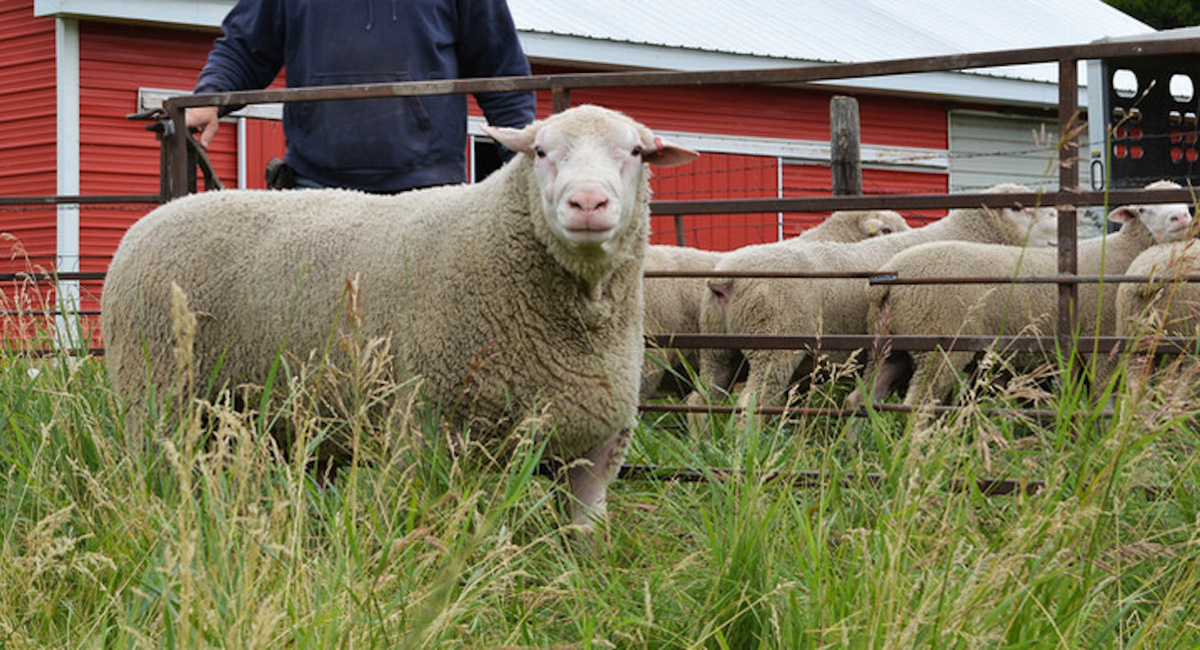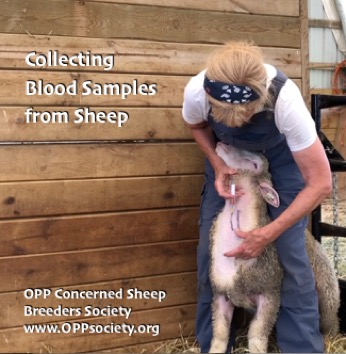OPP Testing 101
“We used AGID testing and culling to rid the flock of OPP. Will continue to test every other year and all new sheep that enter. We are very glad that we are OPP negative. Lambing is now a total joy!”
WILL & KOYLA KRUSE
SOUTH DAKOTA, 280 EWES
————————-
“Used whole-flock AGID testing and culling to achieve 100% negative status. Have seen an all around improvement in flock health.”
TOM AND MARILYN SCHWEBACH
SOUTH DAKOTA, 800 EWES
Since the OPP Concerned Sheep Breeders Society is often asked where samples should be sent for testing — and which test should be used — we have compiled the following information to assist you and your veterinarian in deciding what’s best for your flock. It is important to remember that no diagnostic test is 100% accurate in all cases. Over time, however, you should see consistency in test reports. If you experience wide, unexplainable swings in results from test to test, you may want to consider a different lab.
SPEND WISELY! Eradication of OPP is a significant investment that requires careful planning and vigorous follow-through. When animals are tested for the first time, a partial-flock screening (see more below) can save considerable $$$. If infection is found, explore all options and plan before you proceed. Be aware that there are various paths to success — no one-size-fits-all — and multiple tests will be needed to confirm OPP status.
Always use an accredited lab!
Since antigen purity and adequate lab controls are extremely important, we recommend that samples be sent only to a lab that is accredited by the American Association of Veterinary Laboratory Diagnosticians (AAVLD). Several are listed at the bottom of this page.
High quality samples help ensure accurate results:
Clear to straw colored serum is the goal. When collecting blood, every effort should be made to avoid hemolysis, the bursting of red blood cells. So if using a disposable syringe rather than collecting directly into tubes via a Vacutainer needle, take care to direct blood flow toward the inner wall of the specimen tube to avoid splashing. Serum samples may be frozen, but never freeze whole blood; remove clots unless serum-separator tubes are used. Submit 1 ml of serum for ELISA testing.
ELISA (enzyme-linked immunosorbent assay):
The ELISA detects viral infection by identifying antibody response. The primary advantage of this test is that it is read by a machine rather than by a human, thus eliminating the subjectivity factor. One drawback is that ELISAs can be overly sensitive, sometimes giving results that are falsely positive.
The first ELISA for OPP, using antigen produced by tissue culture, was developed at Cornell University in the mid-1980s but it was discontinued due to high cost. Subsequently, various more sophisticated ELISAs have been used in research facilities and two are now commercially available in the US.
Most recently (fall 2013) the University of Minnesota imported Elitest®1,4 which is the only OPP/CAE ELISA to have been validated according to World Organization for Animal Health (OIE) standards. The Elitest® is available to any producer at a cost of $6.50 per sample if Minnesota resident (out-of-state submissions add 10%). We remain hopeful that other AAVLD labs will begin to offer this test at some time.
Also available at many labs in the US is a competitive ELISA (VMRD cELISA), which was developed for use in goats but is USDA-licensed for both sheep and goats at a positive/negative cutoff of 35% Inhibition. However, USDA researchers have determined a lower 20.9% cutoff when this test is used for sheep1,3, and our experience leads us to recommend that this lower threshold be applied when eradication is the goal.
AGID (agar gel immunodiffusion):
The USDA-licensed AGID test is no longer available as the developer and sole supplier of the test kits ceased operations in 2019.
PCR (polymerase chain reaction):
The PCR has long been used for OPP testing in research facilities and first became available to producers in 1999. While no silver bullet — like other tests, the PCR is not infallible — this test is designed to detect the actual presence of the virus rather than relying on antibody response to infection. Due to its relatively high cost (~$35 per sample), the PCR is usually reserved for especially valuable animals, or those for which other tests have been inconclusive.
A PCR test for OPP is available at Colorado State University as well as North Dakota State University. Draw 2-3 ml of blood into lavender-top EDTA tubes. Immediately after collecting each sample, thoroughly mix blood by gently rocking the tube back and forth several times. Ship whole blood with ice pack, but do not freeze.
Labs offering TMEM154 testing for susceptibility or resilience to the virus causing OPP:
Neogen Corporation – Lincoln, NE
Superior Farms – Sacramento, CA
The use of genetic testing to increase flock resilience to OPP is a tool that can be utilized to mitigate the virus’s impact on flock productivity. Its use has applications and limitations that shepherds should understand. There is clear evidence that TMEM154 1,1 are less likely to become infected with OPP over their lifetime in the presence of continued exposure to infected animals. The reservoir of the OPP virus in a flock is the infected animals that can be identified with serological testing. If eradication of OPP is the shepherd’s goal, then removal of the reservoir by serological testing and culling of positive animals is necessary. Follow up application of biosecurity principles and surveillance are necessary to maintain OPP negative status.
References:
- Comprehensive OPP Info Sheet from AASRP (American Association of Small Ruminant Practitioners):
Holly Neaton, DVM, June 2021 - Effect of TMEM154 E35K variant (haplotypes 1 and 3) . . . ewe productivity during lifetime exposure:
Dr Thomas W Murphy et al, Journal of Animal Science, October 2021 - VMRD cELISA testing of Sheep vs. Goats: (validation of VMRD cELISA for sheep at 20.9% cutoff)
Dr Lynn Herrmann-Hoesing et al, Clin Diag Lab Immunol, September 2003 - Elitest ELISA testing in the Netherlands (evaluation of an AGID and 5 SRLV ELISAs, including Elitest®):
Dr Marian Aalberts et al, Small Ruminant Research, June 2021
Recommendations for Partial-Flock Testing:
When a flock of unknown status is tested for the first time, only a portion of the animals may be sampled for the initial screening. The table below shows the number of animals 12 months of age and older that needs to be randomly sampled and tested in order to be 95% confident of detecting at least one positive animal if 5% or more of the flock is infected
Flock Size (Sample Size)
<30 (test all)
30 (26)
40 (31)
50 (35)
60 (38)
70 (40)
80 (42)
90 (43)
100 (43)
120 (47)
140 (48)
160 (49)
180 (50)
200 (51)
250 (53)
300 (54)
350 (54)
400 (55)
450 (55)
500 (56)
600 (56)
700-800 (57)
1000 (57)
2000 (58)
NOTE: Since sampling a truly random subset can present difficulties at the management level, it is recommended to select for testing only those animals that have been in the flock for at least two years, with ample representation of all ages. This may increase the odds of detecting infection at the flock level.
Collecting Blood and Submitting Samples for OPP Testing:
We recommend that you connect with your local veterinarian as they have the equipment and technical expertise necessary for high quality sample handling and submission. They will also be aware of testing options available at your state’s lab, and the cost. Regardless of which AAVLD-accredited lab is selected, carefully completed paperwork will help to ensure fast turnaround.
SPECIMEN TUBES:
For collecting blood samples, use silicone treated glass tubes with red or mottled red/grey rubber stopper caps. (Be aware that the latter, often called “tiger-tops,” are serum-separator tubes which must be centrifuged prior to submitting to the lab.) The 13 x 100 mm size (1/2” diameter, 4” long) works whether collecting with a syringe or directly into the tube using a Vacutainer needle and holder. For submitting serum, tubes can be either glass or plastic. Please do not submit slim (pencil diameter) tubes or those less than 3” in length.
BLOOD DRAW:
A 3 ml draw is adequate and can be done using a disposable syringe or a double-ended Vacutainer needle with holder. In either case, use a new, sterile needle/syringe and specimen tube for each animal. If collecting with a syringe, blood must then be transferred immediately and carefully into a tube by inserting the needle through the rubber cap. While transferring, be aware that the tube has a vacuum and you want to avoid “splashing” which can cause red blood cells to burst. So try to direct the needle toward the inside wall of the tube, allowing blood to flow gently down the side. If red blood cells do burst, and this may be unavoidable, your serum will be pink or red. That’s OK, but straw colored serum is the goal.
SERUM ONLY:
No blood clots! Submit only serum separated from clotted blood (1 ml is adequate). Your veterinarian can spin samples in a centrifuge to separate the clots, which must then be removed unless samples have been collected in serum-separator tubes. Alternatively, blood can be allowed to clot at room temperature in the red-top tubes (tubes upright) and then serum poured into a fresh tube. Serum may be refrigerated or frozen. If samples have been frozen, be sure to note this on your submission form.
LABELING:
Using a permanent marker so the ink won’t smear when wet, number tubes 1 through XXX. This number should be dark, written with care so it’s easy to read, and placed at the very top of the label (nearest the rubber stopper/cap) while the tube is held upright. Then, turning the tube on its side (horizontal), write the date drawn, the individual animal ID, and your last name. Organize tubes in numerical order, matching the sequence noted on your submission form.
PAPERWORK:
Screen-fillable submission forms can be found on the lab’s website (see below), or you can print a copy and complete it by hand. All information on the form must match the labels on the tubes, and the completed form should be placed in a Ziploc bag separate from the sample tubes. Submit under your veterinarian’s name, noting whether blood was drawn by you or by the veterinarian. Do not include payment; the lab will bill you.
PACKING/SHIPPING:
Pack tubes carefully in a strong carton to avoid breakage (mailing boxes may be available at no charge; see the lab’s website), enclosing absorbent material inside a leak-proof inner wrap. Tubes may be shipped in a horizontal position but be sure to keep them in numerical order. For highest quality samples, ship with a frozen gel pack and mail early in the week to avoid weekend layover. U.S. Priority Mail is fast and economical. Important to mark box with the words “Exempt Animal Specimens.”
Since some states do not have an AAVLD accredited laboratory, suggested labs are noted below. For a complete list, see www.aavld.org
University of California-Davis
530-752-8709
cahfs.vetmed.ucdavis.edu
Colorado State University
970-297-4109
csu-cvmbs.colostate.edu/vdl
**PCR test available
Iowa State University
515-294-1950
vdpam.iastate.edu
University of Minnesota
612-624-0497
vdl.umn.edu
**Elitest ELISA available
Cornell University
607-253-3900
diaglab.vet.cornell.edu
South Dakota State University
605-688-5171
sdstate.edu/adrdl
University of Wisconsin, Barron
715-637-3151
wvdl.wisc.edu
Texas A&M University
979-845-3414
tvmdl.tamu.edu
North Dakota State University
701-231-8307
vdl.ndsu.edu
**PCR test available
Washington State University
509-335-9696
waddl.vetmed.wsu.edu

